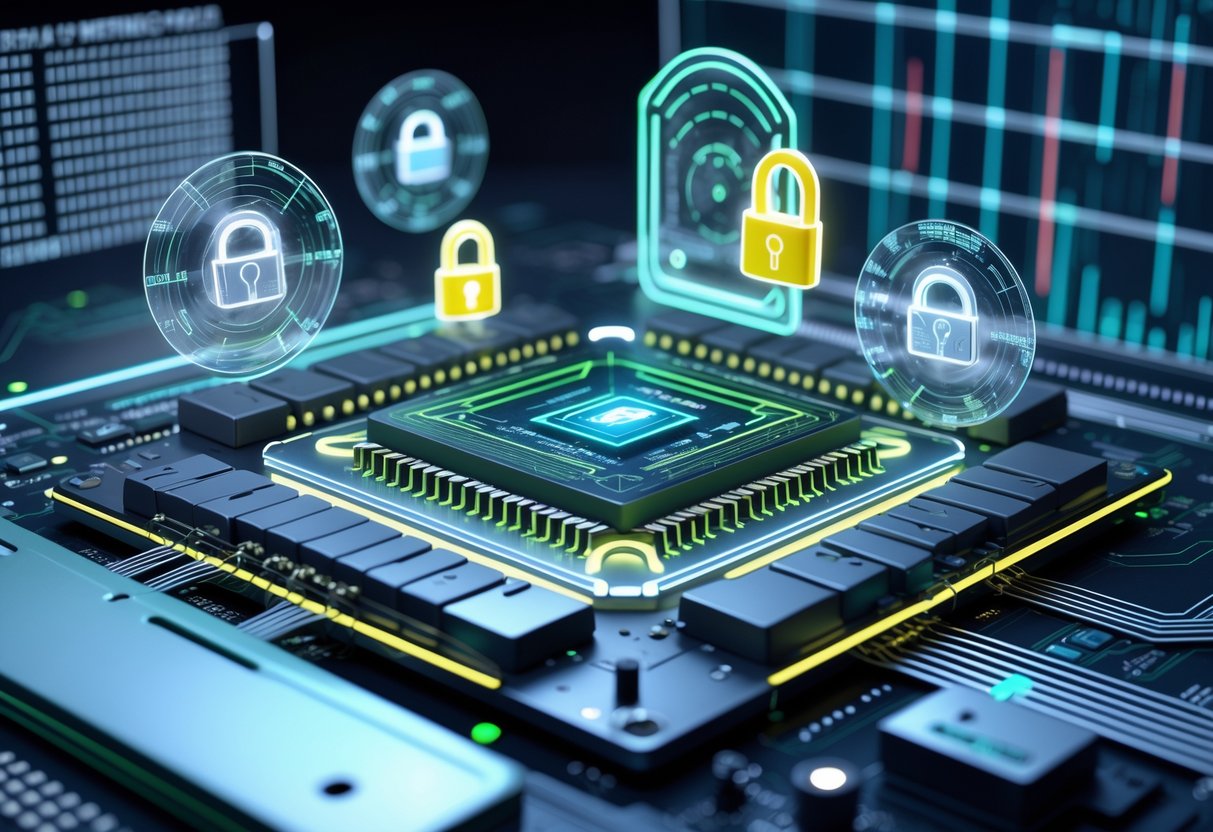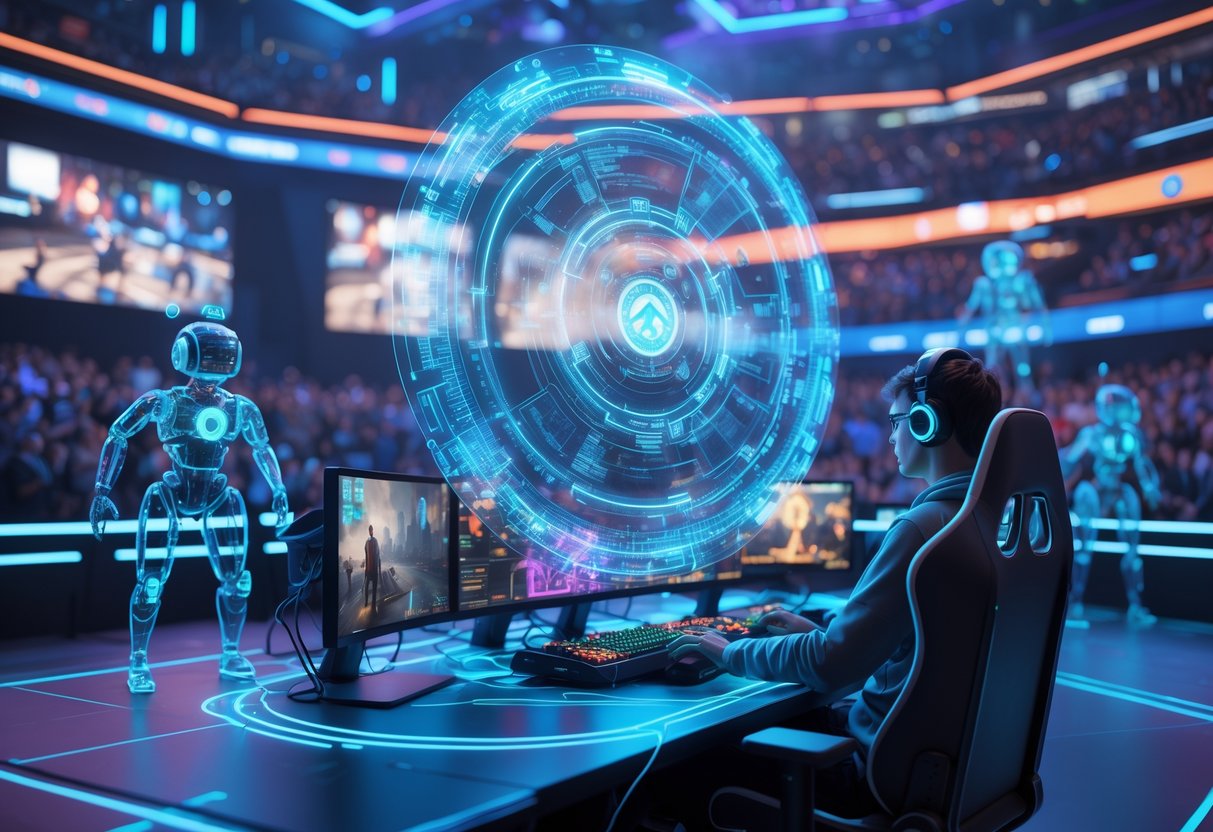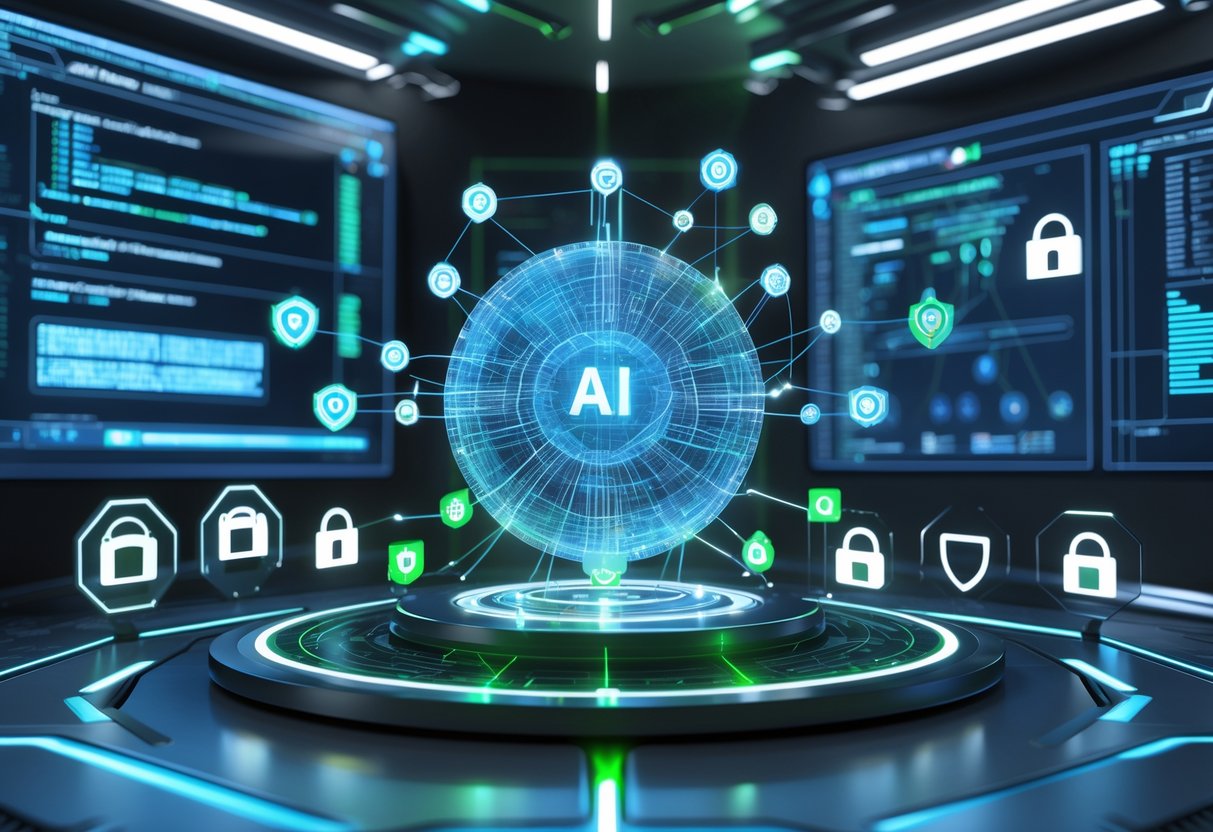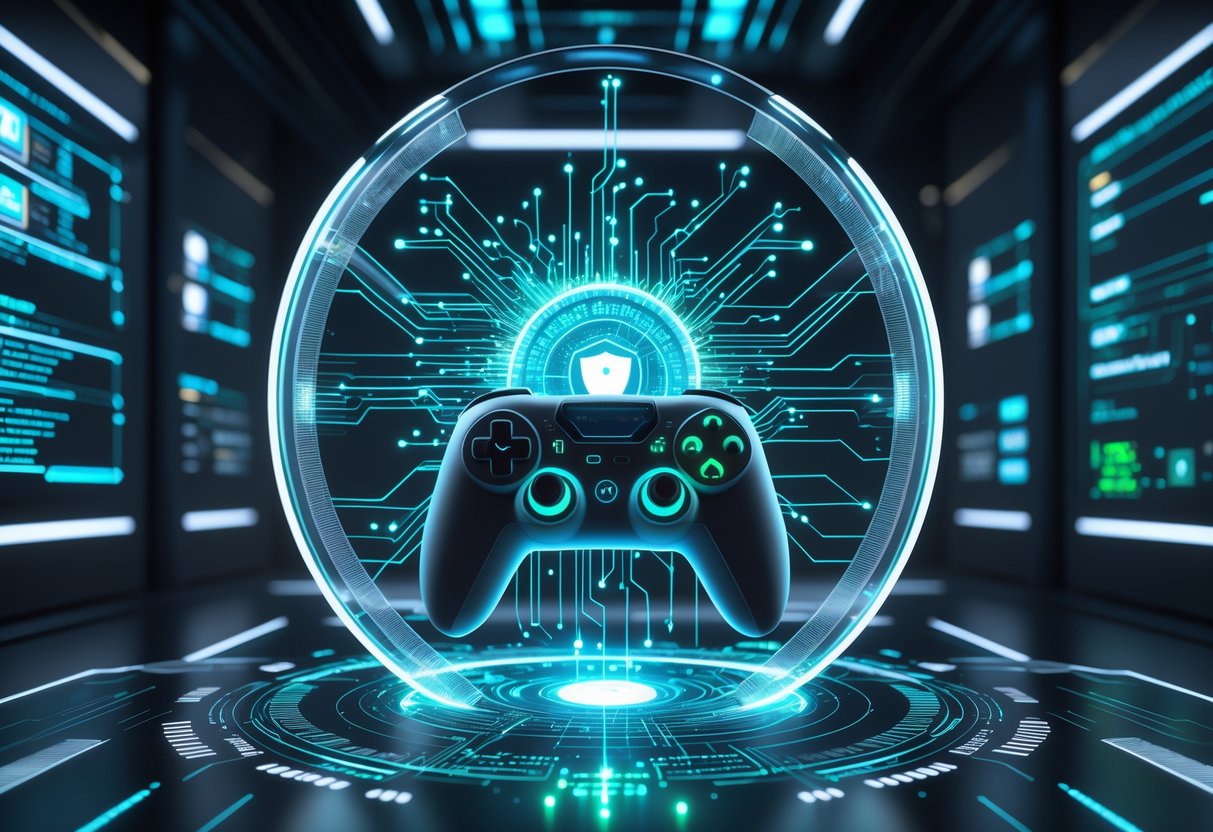AI Anti-Cheat Systems Explained: Safeguarding Competitive Gaming
Updated On: November 13, 2025 by Aaron Connolly
What Are AI Anti-Cheat Systems?
AI anti-cheat systems tap into artificial intelligence and machine learning to catch cheaters in online games. They analyze how players behave, looking for patterns that just don’t add up.
These tools protect competitive integrity by spotting suspicious actions that older software might overlook.
Definition and Core Goals
AI anti-cheat systems act as security tools that use artificial intelligence to identify and stop cheating in competitive games. Instead of only hunting for cheat programs, they actually watch what players do during matches.
The main goals are pretty clear:
- Detect suspicious gameplay in real time
- Protect fair competition in ranked and tournament play
- Cut down on false bans with smarter analysis
- Adapt on their own to new cheating tricks
Systems like Riot’s Vanguard and Valve’s VACNet crunch millions of data points every second. They look for things like impossible moves, lightning-fast reactions, and aiming that seems a bit too perfect.
They compare each player’s actions to huge databases of legit gameplay. If someone keeps pulling off moves that no human could, the AI sends up a red flag for a closer look.
AI Versus Traditional Anti-Cheat Software
Traditional anti-cheat software mostly relies on signature detection. It hunts for known cheat programs by scanning for their code. That worked for a while, but these days, cheats change too fast.
Here’s a quick breakdown:
| Traditional Systems | AI Systems |
|---|---|
| Hunt for cheat program files | Analyze how players behave |
| Can’t keep up with new cheats | Adapt on the fly |
| Lots of false bans | More accurate at catching real cheaters |
| React to problems | Monitor proactively |
AI uses machine learning algorithms to spot patterns people might miss. Even if the cheat software hides itself, AI can pick up on weird gameplay.
Say a player uses an aimbot that looks legit to most folks. AI can still spot the tiny, robot-like adjustments and flawless tracking that give it away.
Traditional systems often issue bans in waves after they find a new cheat. AI can catch cheaters in the act, right as they play.
Importance for Competitive Integrity
Competitive integrity really is the backbone of pro esports, which has exploded into a multi-billion pound industry. AI anti-cheat systems help keep things fair.
The numbers are wild. Valve has banned more than 4.5 million Counter-Strike 2 accounts for cheating. Riot’s Vanguard system kicked out 3.6 million Valorant cheaters.
If anti-cheat tech fails, things go downhill fast:
- Players lose faith in ranked ladders
- Viewers start to doubt the matches
- Sponsors might bail from tainted tournaments
- Prize money starts to feel pointless
James Connolly, a gaming expert, says, “When cheating gets out of hand, the whole scene crumbles. Players stop caring, fans tune out, and the industry takes a hit.”
AI helps keep things fair by catching cheaters before they can ruin matches. This matters for both casual players grinding ranked and pros chasing big prizes.
There’s also a deterrent factor. Knowing that AI is watching every move makes a lot of would-be cheaters think twice.
How AI Powers Modern Anti-Cheat Solutions
AI anti-cheat systems today rely on machine learning to spot player behaviour that just doesn’t fit. They learn what normal play looks like and flag players who pull off impossible stuff or act strangely.
Machine Learning for Behavioural Analysis
Machine learning is the heart of these modern anti-cheat tools. They study millions of hours of gameplay to figure out what “normal” really means.
Valve’s VACNet, for example, checks how players aim, move, and react every match. The AI picks up on details people might never notice.
It tracks things like reaction times, mouse movement, and accuracy. Most players have a bit of delay and their aim isn’t perfect.
Behavioural analysis catches those who suddenly start playing like machines. If someone’s headshot rate jumps from 15% to 95% overnight, the system notices. It also flags players with reaction times that are just too fast to be real.
AI systems keep an eye on:
- Aim smoothness: Is it human or too perfect?
- Pre-firing: Shooting before enemies even show up
- Crosshair placement: Staring at walls where enemies hide
- Reaction times: Is it superhuman?
Riot’s Vanguard has used this tech to ban over 3.6 million Valorant accounts. The artificial intelligence doesn’t just catch the obvious cheaters. It even picks up on subtle tools that give players a slight edge.
Adaptation to Novel Cheating Tactics
Old-school anti-cheat struggled because it only caught cheats it already knew about. Developers kept updating their cheats, making it a never-ending chase.
Machine learning flips the script by focusing on what players do, not what software they use.
AI keeps learning from new games and new data. When cheat makers invent something new, the system looks for the weird gameplay patterns that result. That makes life a lot harder for cheaters.
These systems keep getting better as they see more data. They grow their understanding of both legit and sketchy behaviour. Counter-Strike 2’s system has banned millions by spotting patterns across all sorts of cheats.
Experts call this an “arms race” between AI and cheat makers. But AI has a big edge—cheats almost always change how people play, and that’s tough to hide.
Behaviour Versus Signature Detection
Old anti-cheat relied on signature detection—basically scanning for cheat code. That worked when cheats were simple, but now they’re encrypted and change all the time.
Cheat detection through behaviour analysis just watches what players do. If someone uses wallhacks, they’ll look at enemies through walls, even if the software stays hidden.
Here’s the difference:
| Traditional Method | AI Behaviour Analysis |
|---|---|
| Scans for cheat files | Watches player actions |
| Needs constant updates | Learns on its own |
| Easy to trick | Much harder to fool |
| Works after matches | Catches cheaters live |
Behaviour-based systems can spot cheaters using hardware or super-advanced software. The AI doesn’t care how you cheat—it just notices when you do the impossible.
It’s a big shift. Instead of just playing whack-a-mole with software, we’re finally watching the players themselves.
Key Detection Methods in AI Anti-Cheat Systems
AI anti-cheat systems use three main tactics: they watch how players act in-game, scan for known cheats, and keep an eye on what’s going on inside your computer’s memory. Each one tackles a different angle, and together, they’re pretty tough to beat.
Behavioural and Statistical Analysis
Behavioural analysis is the backbone of modern AI anti-cheat. These systems figure out what normal play looks like by studying millions of hours of real matches.
The AI looks for patterns that just don’t make sense. Nobody can aim perfectly every time or react instantly. If someone’s accuracy jumps from 60% to 98% overnight, the system gets suspicious.
AI systems track stuff like:
- Mouse movement and how smooth it is
- How fast players react to enemies
- Shot accuracy at different ranges
- How players move and position themselves
- Decision-making during key moments
VACNet checks all these things in real time. If someone’s stats suddenly get weird, the system sends a report to a human reviewer.
Statistical analysis can even catch sneaky cheats. Even when cheaters try to look human, AI can spot the little inconsistencies over thousands of games.
Signature-Based Scanning
Signature detection is kind of like antivirus for games. The system keeps a database of known cheats and scans for their unique code.
When new cheats pop up, anti-cheat teams dig into the code and create a “signature”—basically a cheat fingerprint. The scanner then looks for these fingerprints in running programs.
Modern signature scanning checks:
- File hashes
- Memory patterns
- Network traffic
- How processes behave
This method catches a lot of basic cheats fast. But cheat makers keep tweaking their code to dodge detection, so the battle never really ends.
The big downside? Brand-new cheats don’t have signatures yet. That’s why cheat detection needs a mix of tools working together.
Process and Memory Monitoring
Process monitoring lets anti-cheat systems see what’s happening on your computer at a deep level. These tools often run at the kernel level, so they start up with your computer and watch everything.
Riot’s Vanguard is a good example. It boots with your PC and looks for suspicious processes trying to mess with games or memory.
Process monitoring can spot:
- Programs reading game memory
- Attempts to inject code
- DLL modifications
- Hardware cheats using extra devices
- Screen capture tools used by AI cheats
Memory monitoring checks for changes to game data while you play. If something suddenly tweaks your character’s position, weapon stats, or visibility, the system catches it right away.
This approach works really well, but it’s not without controversy. Some players worry about privacy, since these systems could technically see all activity. Still, companies like Riot and Valve say they only collect data for cheat detection.
Hardware cheats are a new headache. Some cheaters use devices that watch your screen and send fake input. AI systems are learning to spot the weirdly perfect moves these gadgets create.
Overview of Leading AI-Powered Anti-Cheat Platforms
Three big platforms lead the AI anti-cheat world right now. Vanguard is famous for its strong protection in Valorant and League of Legends. Newer systems like ACE for Delta and ABI focus on mobile gaming, and Easy Anti-Cheat covers loads of different games.
Vanguard by Riot Games
Vanguard is one of the most aggressive AI anti-cheat systems out there. Riot Games built it for Valorant and League of Legends.
It runs at the kernel level, which means it’s active as soon as your computer starts up. Vanguard doesn’t just watch when you’re in-game—it’s on all the time.
What makes Vanguard stand out:
- Always-on, 24/7 protection
- Can hardware ban cheaters
- Uses machine learning to analyze gameplay
- Detects sketchy behaviour in real time
Since Valorant dropped, Vanguard has banned over 3.6 million accounts. It mixes deep system access with AI that spots unnatural aiming and reaction times.
A lot of players pushed back at first because of privacy worries. But honestly, most of the competitive scene has come around after seeing how well it works.
ACE for Delta & ABI
ACE (Anti-Cheat Engine) targets mobile gaming, especially platforms like Delta and ABI. Mobile cheating brings its own set of headaches, so ACE has to work differently.
Touch controls, different phones, and a bunch of operating systems make cheating on mobile a unique challenge.
ACE’s mobile approach:
- Analyzes touch input for weirdly precise actions
- Looks at sensor data for impossible moves
- Uses replays to review suspicious matches
- Focuses on gameplay data, not personal info
ACE works with mobile games as they are, so developers don’t have to overhaul everything. It reviews replays to spot cheats that people might miss.
As mobile esports keeps growing, ACE is becoming more and more important. Games like PUBG Mobile and Call of Duty Mobile now hand out millions in prize money.
Easy Anti-Cheat (EAC) Solutions
Easy Anti-Cheat stands out as the most widely adopted AI-powered anti-cheat platform. EAC protects over 200 games on PC, PlayStation, and Xbox.
Epic Games owns EAC and offers it as a service to game developers. Developers get ready-made anti-cheat protection without the headache of building their own systems.
EAC’s Broad Compatibility:
- Works on Windows, Mac, and Linux
- Integrates with Unreal Engine and Unity
It supports both competitive and casual games. EAC provides real-time monitoring and even automated banning.
The AI components dig into player stats, movement, and shooting accuracy. EAC flags accounts that consistently play at levels no human could reach.
Games like Fortnite, Apex Legends, and Fall Guys rely on EAC. The system processes millions of matches every day, kicking out cheaters automatically.
EAC aims for strong protection with barely any performance impact. Most players probably never even notice it’s there.
Role of Kernel Drivers and Hardware Bans

Kernel drivers operate right at your system’s core to catch advanced cheats. Hardware bans target your actual computer parts, blocking banned players from coming back.
Both methods offer powerful protection for competitive gaming, but they raise serious privacy concerns.
Kernel-Level Access: Functionality and Risks
Kernel-mode drivers run at the deepest level of your operating system. Anti-cheat systems like Vanguard, BattlEye, and Easy Anti-Cheat use them to monitor everything happening on your computer.
These drivers catch sophisticated cheats that slip past normal software. They look for unauthorized memory access, process injection, and stealthy input automation.
Key monitoring capabilities:
- Real-time memory scanning for aimbots and ESP overlays
- Detection of driver tampering and process manipulation
They can intercept system calls to spot automated inputs. They also analyze hardware-level interactions.
But the cybersecurity risks are real. Kernel drivers can make your system unstable, open potential backdoors, or crash your PC if something goes wrong.
Developers need to audit these drivers carefully to avoid security flaws.
Some systems, like Vanguard, keep running even when you’re not gaming. That helps catch cheats that load before the game starts, but it’s a little unsettling to know your system’s being watched all the time.
Implementation of Hardware Bans
Hardware bans go after your computer’s unique physical identifiers, not just your account. If you’re hardware banned, the anti-cheat system blocks your specific machine from the game.
Common hardware identifiers:
- Motherboard serial numbers
- CPU identifiers
They also use hard drive signatures, graphics card details, and MAC addresses.
Easy Anti-Cheat and BattlEye both use hardware fingerprinting. They create a unique profile of your machine that sticks around even if you make a new account or reinstall Windows.
Hardware bans work especially well against repeat offenders. Account bans just mean buying another copy, but hardware bans force cheaters to replace expensive parts.
Of course, some cheaters use HWID spoofing tools to fake their hardware signatures. It’s a constant arms race—anti-cheat developers adapt, and cheat creators find new tricks.
Controversies and Privacy Considerations
Kernel-level anti-cheat systems stir up a lot of debate about privacy and security. These tools basically install rootkit-level software that watches your whole system, not just the game.
Plenty of players dislike the amount of data these systems collect. Anti-cheat can, in theory, access any file, monitor all your processes, and track your system’s behavior.
Main privacy concerns:
- Constant background monitoring of your system
- Access to personal files and sensitive data
There’s also the risk of data breaches or misuse. And honestly, most companies aren’t super clear about what they collect.
The cybersecurity community doesn’t really agree on this. Some experts say kernel access just creates new security holes. Others argue it’s necessary to catch the most sophisticated cheats.
Microsoft plans to limit kernel access in future Windows versions. That could force anti-cheat developers to find new ways to detect cheats without such deep system privileges.
Players in places like the EU have pushed for more transparency. Some developers now publish clearer documentation about what their anti-cheat looks at and how long they keep your data.
Comparing Popular Anti-Cheat Solutions

The anti-cheat world in 2025 is crowded with heavy-hitters, each with their own way of catching cheaters. Vanguard and ACE use aggressive AI and kernel-level access. BattleEye, Easy Anti-Cheat, and Valve Anti-Cheat take other routes.
Vanguard versus ACE
Vanguard is Riot Games’ flagship anti-cheat, protecting Valorant and League of Legends. It runs at kernel level and starts with your system boot.
The system combines AI-driven behavioral analysis with hardware fingerprinting. If Vanguard spots cheating, it issues permanent hardware bans that make it nearly impossible to come back.
ACE covers games like Delta and ABI with similar aggressive detection. It leans on AI-powered heuristics to analyze player behavior, not just scan for known cheats.
Both systems have similar strengths: kernel-level access, permanent HWID bans, and adaptive AI. The main difference? Vanguard is always on, while ACE focuses on game-time monitoring.
| Feature | Vanguard | ACE |
|---|---|---|
| Kernel Access | Always-on | Game-active |
| AI Detection | Behavioral + signature | Heuristic patterns |
| HWID Bans | Permanent | Permanent |
| Privacy Impact | High system access | Moderate access |
BattleEye, EAC and Valve Anti-Cheat
BattleEye protects games like PUBG and Rainbow Six Siege with signature detection and network monitoring. It scans for known cheat programs but doesn’t dig as deep as Vanguard or ACE.
Easy Anti-Cheat (EAC) tries to balance things on games like Fortnite and Apex Legends. It focuses on process scanning and signature detection, skipping the kernel access. EAC does HWID bans but mostly targets known cheat software.
Valve Anti-Cheat covers Counter-Strike and other Steam games through VACNet AI. It analyzes gameplay demos to spot suspicious patterns and is generally less intrusive than kernel-level systems.
These systems aim for compatibility and user privacy. They’re good against common cheats but have a harder time with sophisticated private hacks.
Strengths and Weaknesses
Kernel-level systems like Vanguard and ACE catch more cheats with deep system monitoring and AI. They can spot advanced hacks and enforce permanent hardware bans.
But they come with privacy concerns and can cause compatibility headaches. Some users just turn them off because of performance or security worries.
Traditional systems like BattleEye and EAC protect well without digging deep into your system. They work against known cheats and keep things compatible for most hardware.
Their main weakness? They react to cheats instead of predicting them, so new hacks can slip through before detection updates roll out.
Choosing between these systems really comes down to what matters more: maximum security or more privacy and compatibility.
AI in Esports and Competitive Gaming

AI systems now guard major tournaments with millions in prize money. They catch cheaters in real-time and analyze player behavior patterns.
Pro players rely on these systems to keep competition fair across games like Valorant and League of Legends.
Safeguarding Tournament Integrity
Tournament organizers face huge risks if cheaters get through. One scandal can wreck years of reputation and cost millions in sponsorships.
VACNet and Vanguard are leading the charge here. Valve’s system has banned over 4.5 million Counter-Strike accounts. Riot’s Vanguard removed 3.6 million cheaters from Valorant.
These systems don’t work like the old ones:
| Traditional Anti-Cheat | AI-Powered Systems |
|---|---|
| Detects known cheat software | Analyzes player behavior patterns |
| Reactive approach | Predictive detection |
| Easy to bypass | Learns and adapts |
Big tournaments now use multiple AI layers. Hardware checks verify equipment. Real-time monitoring watches for impossible plays. Post-match analysis reviews anything suspicious.
Honestly, top tournaments run way smoother now than five years ago. That’s AI anti-cheat working behind the scenes.
Player Behaviour and Detection
AI systems learn what normal gameplay looks like. They spot tiny differences that give away cheating software.
Pattern recognition focuses on three things:
- Aim patterns – Humans miss shots and have shaky hands
- Reaction times – Even pros react within certain ranges
They also look at game sense – real players make mistakes.
The tech analyzes millions of data points per match. It compares each player to a huge database of legit gameplay.
FACEIT’s Minerva system is a good example. It processes 3 million matches a month, scans 110 million messages, and reviews 200,000 hours of voice chat for toxic behavior.
But let’s be honest: these systems aren’t perfect. False positives happen, so human reviewers still make the final call on bans.
Pro players generally support strict detection. Their careers depend on fair play, and one cheating scandal can sink a whole league.
Impact on Professional Gamers
Pro gamers benefit the most from strong AI anti-cheat. Their livelihoods depend on fair play and fan trust.
Career protection is huge. Players spend years building skills and reputations. Cheaters can wreck a legit player’s earnings and tournament shots.
Viewer confidence keeps the whole thing alive. If fans trust what they see, the money keeps coming in. Prize pools get bigger. More opportunities open up.
The numbers speak for themselves:
- Global esports market: £1.72 billion in 2023
- Projected growth: £9.29 billion by 2032
Counter-Strike tournaments already break £2 million in prizes. League of Legends Worlds goes beyond £5 million.
Gaming expert James Connolly says: “Players who competed for pizza money ten years ago now see single tournaments worth more than most people’s annual salaries. That financial pressure makes robust anti-cheat systems essential.”
Competitive integrity is the foundation. Without it, competitive gaming just turns into entertainment instead of a real sport.
Technical Challenges and Cheat Evasion

AI anti-cheat systems face nonstop attacks from cheaters using clever evasion tactics. Developers have to keep adapting to counter new cheating methods.
Evasion Tactics Used by Cheaters
Cheaters use several crafty tricks to dodge AI systems. Memory injection lets cheat software hide inside a game’s memory, making it tough for anti-cheat to spot the bad code.
Code obfuscation scrambles cheats to look like normal programs. It’s like writing in a secret language—the cheat works, but detection systems can’t recognize it.
Some cheaters use external hardware devices that sit between the mouse and computer. These gadgets adjust aim or trigger actions automatically. Since they don’t touch the game’s code, they’re extremely hard to detect.
Timing manipulation is another trick. Cheaters add random delays and imperfect movements to make their boosted performance look human. That helps them slip past behavior analysis.
AI-Based Cheating Tools
Ironically, artificial intelligence now powers some of the most advanced cheats. Visual AI cheats use computer vision to analyze what’s happening on screen. They can spot enemies through walls or auto-aim without ever touching the game code.
It’s basically like having a robot watch your screen and move your mouse. Some of these cheats even use machine learning to get better over time.
ChatGPT and similar AI models help cheaters write more complex scripts and automation tools. You don’t even need to know how to code anymore to make powerful cheats.
The scary part? These AI cheats can mimic human behavior. They add realistic reaction times, miss shots on purpose, and change up their play style to fool detection systems.
Arms Race Between Cheaters and Developers
The fight between cheaters and developers just never ends. Developers roll out new anti-cheat systems, but cheaters seem to come up with fresh tricks almost overnight. Honestly, it feels like a never-ending game of cat and mouse.
You can see this in how fast things move. Anti-cheat updates might block cheaters for a week or two, but new exploits usually pop up just as quickly. There’s a lot of money on the line—some cheat creators rake in thousands from subscriptions.
Game studios now pour millions into anti-cheat research. They bring in cybersecurity pros, hire machine learning engineers, and keep tweaking their detection algorithms. Some companies push updates every single day to try to stay ahead.
Now, there’s a shift toward hardware-level protection. Tools like Riot’s Vanguard dig deep into your computer’s core, but that’s sparked plenty of privacy debates among regular players. Striking the right balance between security and user rights? That’s still a tough nut to crack.
Security, Privacy and Transparency

AI anti-cheat systems need deep access to your PC to work well. That opens up some big questions about privacy, system safety, and how open game companies are about what they’re watching. These systems have to detect cheats without trampling on player trust or data.
User Privacy Protection
Modern anti-cheat tools scoop up lots of data to spot unusual patterns. They track stuff like mouse movement, keyboard input, what’s running on your PC, and even your hardware details.
What data gets collected:
- Hardware identifiers (HWID)
- Active processes and apps
- File system changes
- Network traffic patterns
- Input timing and behaviour
Protecting all this sensitive info isn’t easy. Game companies need to encrypt everything in transit and at rest. They should really stick to the least privilege principle—just grab what’s absolutely needed to catch cheaters.
Some systems now use data segmentation. Personal info stays separate from gameplay data, and regular audits check that companies keep their privacy promises.
Players deserve to know what gets collected. In some places, like the EU, companies have to get opt-in consent for certain kinds of monitoring.
Driver Safety and System Stability
Anti-cheat software often needs kernel-level drivers to catch advanced cheats. But giving that much access to your system can cause headaches for stability and security.
Why kernel drivers are used:
- Catch memory hacks and aimbots
- Block process injection attacks
- Watch low-level system calls
- Prevent driver tampering
Kernel drivers run with the same privileges as your operating system. If something goes wrong, you can get crashes or even open up security holes.
Best practices for safe deployment:
- Use sandboxed drivers with limited OS hooks
- Secure updates with code signing
- Prevent rollbacks if updates fail
- Run regular security audits and tests
Developers need to test these drivers on all sorts of hardware. If something breaks, there should be clear uninstall steps and recovery options.
Transparency and Trust in Anti-Cheat
Players want to know what anti-cheat software is actually doing. Nobody likes mysterious “black box” systems that ban people without explanation.
Key transparency measures:
- Publish privacy policies about data collection
- Share public docs on detection methods (when possible)
- Offer appeal processes for false positives
- Post regular community updates on changes
Companies should log every detection with reproducible evidence for support tickets. That way, players can see why they got penalized and hold companies accountable.
Machine learning adds another layer of complexity. Players need at least a basic idea of how behaviour analysis works, but without tipping off cheaters.
Some studios now post transparency reports with ban stats and system updates. That’s a good way to show the system’s working fairly for everyone.
The best anti-cheat systems are upfront about what they monitor. They explain privacy protections in plain language and let players control their data when possible.
The Future of AI Anti-Cheat Technology

AI-powered anti-cheat is moving way beyond simple detection. Cloud-based verification lets companies analyse millions of players instantly. New trends like behavioural profiling might even catch cheaters before they act, and stronger legal frameworks could finally hit cheat developers where it hurts.
Cloud-Based Verification and Real-Time Analysis
Cloud computing is shaking up cheat detection in competitive games. Now, anti-cheat systems process gameplay data on many servers at once.
This setup means you get instant verification of suspicious actions. If someone lands an impossible shot in Counter-Strike 2, cloud AI can check that move against millions of others in milliseconds.
Real-time analysis benefits:
- Respond to cheating instantly
- Ease the load on individual game clients
- Tap into huge databases of cheat patterns
- Coordinate detection across multiple games
Big publishers like Riot Games already use cloud-based anti-cheat for Valorant. Their systems analyze over 3.6 million banned accounts to boost accuracy.
Cloud tech also powers cross-game learning. If someone invents a new aimbot for Valorant, the system can update and block it in other games right away.
Performance still matters. Cloud systems need to process data fast, without lagging gameplay. Edge computing helps by putting servers closer to players.
Emerging Trends and Innovations
AI in cybersecurity is taking anti-cheat to new places. Behavioural analysis now builds a unique “fingerprint” for every player.
These tools learn how you normally aim, move, and make choices. If your style suddenly changes, the system will flag it—even if you’re not using a known cheat.
Key innovations include:
- Biometric profiling—tracking mouse movement and reaction times
- Predictive analysis—spotting cheaters before they strike
- Hardware fingerprinting—noticing odd device changes
- Memory protection—blocking outside programs from poking at game data
Machine learning keeps adapting to new threats. Unlike old-school detection, AI can evolve without waiting for manual updates.
Visual analysis is another big leap. Computer vision can catch unnatural aiming by breaking down gameplay frame by frame.
Some anti-cheat tools now link up with streaming platforms. That lets tournament organizers check player legitimacy in real time.
The battle between cheaters and developers keeps pushing innovation. As cheats get sneakier, AI anti-cheat steps up to keep things fair.
Potential for Legal Action Against Cheat Developers
Legal systems are finally starting to crack down on cheat makers. Courts around the world now recognize the real financial harm cheats cause game studios.
Successful lawsuits are setting some big precedents. In 2024, major publishers won hefty damages from cheat creators, showing there are real consequences.
Legal strategies include:
- Copyright infringement for reverse-engineering game code
- Breach of contract when users break terms of service
- Criminal charges for computer fraud in some places
- Asset seizure from cheat operations
The money at stake makes these cases stronger. Esports could hit £9 billion by 2032, so cheating is a serious business risk.
International teamwork helps enforcement. Cross-border investigations now hit cheat networks harder.
Warning: Lawsuits take time and money. Studios have to weigh the cost against the payoff and how much it scares off future cheaters.
Some developers double down with HWID bans and legal action at the same time. This targets both cheat makers and their customers.
The threat of getting sued might keep some cheat devs away. Still, enforcement isn’t always consistent from country to country.
Impacts on Games and Player Experiences

AI anti-cheat is changing how people play competitive games. These systems boost community trust and make matches fairer, so players can focus on skill development instead of looking for shortcuts.
Effect on Community Trust
When people trust the matchmaking, they stick around longer. AI anti-cheat like VACNet and Vanguard have kicked out millions of cheaters from top games.
Valve banned 4.5 million Counter-Strike 2 accounts with their AI system. Riot removed 3.6 million cheaters from Valorant. Those numbers show how much protection players get now.
Before AI anti-cheat:
- Cheaters showed up all the time
- Players quit matches early when they saw obvious hacks
- Forums were full of complaints about unfair play
After AI implementation:
- Cheating reports dropped a lot
- More players stuck with ranked modes
- Reviews improved for games with strong anti-cheat
Gaming expert James Connolly says, “players invest more time and money when they trust the competitive integrity of a game.”
Esports tournaments really benefit from this trust. Fans can watch knowing the games are legit, which brings in more viewers and sponsors.
Changes in Player Behaviour
AI anti-cheat has changed how people play. Instead of worrying about cheaters, players now work on getting better.
Lots of players spend more time in practice modes. Knowing cheaters get caught quickly pushes fair players to actually improve their skills.
Key behavioural changes:
- More people join ranked matches
- Players spend extra hours on aim training and strategy
- Teams communicate better
- Less toxicity after matches
Players also seem more patient after losses. They know losing comes down to skill, not hacks.
New players feel more welcome in competitive games. They’re less likely to run into cheaters and quit out of frustration.
Long-Term Influence on Game Development
Game studios now build anti-cheat into their games from the start. That changes how games get designed.
Modern titles include AI systems that watch player behaviour. These tools help balance the game and spot when someone exploits mechanics.
Development changes include:
- Anti-cheat gets added early in development
- More server-side checks on player actions
- Better data collection for behaviour analysis
- Tougher hardware ID systems
Developers put more resources into anti-cheat because it protects their whole ecosystem. A game with strong integrity can make money for years.
The esports scene drives a lot of this. With prize pools in the millions, studios know competitive integrity is key to success.
Frequently Asked Questions

AI-powered anti-cheat uses machine learning to watch player behaviour and catch suspicious activity in real time. These tools address big concerns about fairness, privacy, and effectiveness in competitive gaming.
How does AI-based anti-cheat software enhance gaming fairness?
AI anti-cheat tools level the playing field by spotting subtle cheats that old systems might miss. They scan thousands of data points every second—mouse movement, reaction times, and gameplay choices.
The tech can flag unnatural stuff like perfect aim or impossible reflexes. That means honest players are less likely to run into cheaters.
For instance, Riot’s Vanguard has kicked out more than 3.6 million cheaters from Valorant. Valve’s VACNet banned 4.5 million Counter-Strike 2 accounts using AI.
What are some key advantages of using AI to detect cheating in games?
AI keeps learning as new cheats show up. Old anti-cheat tools only catch what they already know, but AI can spot brand-new tricks.
Real-time detection is another big plus. AI can flag suspicious behaviour in seconds, not days.
These systems also take work off human moderators. They process millions of games and only send the sketchiest cases for review.
Could you tell me how companies integrate AI anti-cheat systems into their games?
Game studios usually build AI anti-cheat right into the core of their games, often with kernel-level access on players’ PCs. That deep integration helps them spot external cheating tools.
AI runs both on your computer and on company servers. Local checks watch your behaviour, while server-side tools analyse data from everyone at once.
Developers train machine learning models on huge datasets of legit and cheating gameplay. These models get constant updates as new cheats are found.
Are there any privacy concerns associated with the implementation of AI anti-cheat tools?
AI anti-cheat collects a ton of data about your PC and gameplay. That includes what processes are running, your hardware setup, and lots of gameplay stats.
Some tools need to monitor all the time, even when the game isn’t running. That raises questions about how companies store data, who they share it with, and possible security risks.
Players usually can’t opt out if they want to play competitively. Game companies have to juggle cheat detection with privacy rights and data protection laws.
What measures do AI anti-cheat systems take to avoid false positives when flagging players?
Modern AI systems set confidence thresholds before banning anyone. Usually, they flag players for manual review instead of just handing out an automatic ban—unless the system feels really, really sure.
These systems combine several detection methods to lower the risk of false positives. They look for suspicious behavior across different metrics and only act if they spot a pattern.
A lot of companies use staged responses. If you mess up for the first time, you might just get a temporary suspension, while repeat offenders end up with permanent bans. This way, legitimate players who accidentally trigger something get a fair shot.
How do AI anti-cheat solutions stay ahead of ever-evolving cheating methods?
AI learns from every new cheating attempt it runs into. When cheat developers roll out new tools, the AI digs into those methods and tweaks its detection algorithms.
Teams retrain their models all the time. They use fresh data from both recent cheating incidents and honest gameplay.
Some developers actually team up and share info about the latest cheats. This kind of collaboration? It gives the whole gaming industry a fighting chance against cheat makers who never stop coming up with new tricks.

